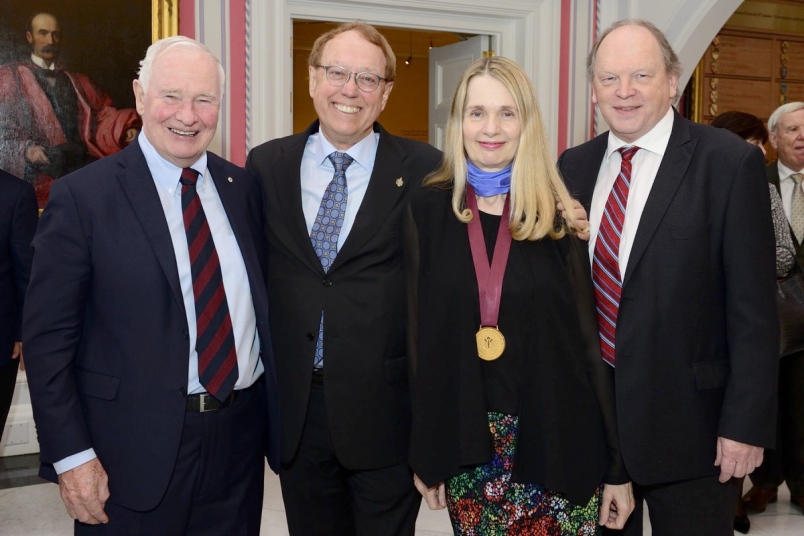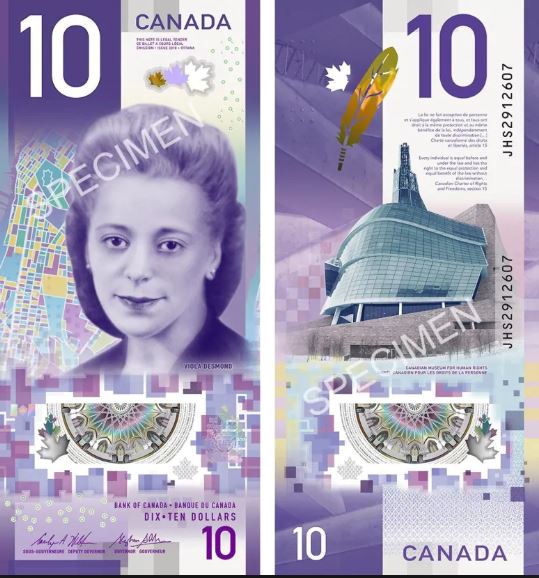
Merna Forster accepts GG Award, photo courtesy of Sgt Johanie Maheu/Times Colonist
Merna Forster ('76 BA) is one of Canada's most dedicated champions of women's history. Her work has led to the advancement of women into the historical record of this country, and into the hearts and minds of Canadians.
The 2016 recipient of the Governor General's History Award for Popular Media (Pierre Berton Award) for her long-fought and ultimately successful campaign to see women featured on Canadian currency, Forster will see her dream realized on December 8, 2016 when Finance Minister Bill Morneau and Bank of Canada governor Stephen Poloz announce which of the five finalists (of461 eligible nominees) has been selected to appear on a bank note in 2018.
It is the culmination of a career spent advocating on behalf of Canada's history, and specifically, the role women have played in building this country.
"Women hold up half the sky - and they should hold up half the bank notes!" says Forster.
As a child, the southern Alberta native loved learning and reading about Canadian history, which she recalls as primarily stories of famous Canadian men. It was later, through her travels and work as a naturalist and civil servant with Parks Canada and the Department of Canadian Heritage that Forster encountered important female historical figures like artist Emily Carr and E. Pauline Johnson - a woman who celebrated her Mohawk heritage in songs, poems and performances. This spurred Forster to create several invaluable historical resources: theheroines.ca website and two popular books,100 Canadian Heroines: Famous and Forgotten Faces and 100 More Canadian Heroines.
"I felt like I needed to know their stories," says Forster. "And to make sure that more people in Canada also knew about women in Canadian history. These women are too often missing from our classrooms and history books."
In 2013, Forster launched a petition in support of memorializing a Canadian woman on Canadian currency. Years of writing op-eds and letters to Members of Parliament and the Bank of Canada followed, but Forster remained unshakable in her determination to see her project through to the end.
"Women are not absent from the list of notable worthies in Canada, just notably absent or underrepresented in many of the images that surround us and which contribute to our view of the world and our potential role in it," she says.
The petition received 73,000 signatures, which not only swayed the Bank of Canada, but also - and perhaps most importantly - led to a national conversation about women and the historical significance of their contributions to Canada. Forster was appointed to an advisory committee along with three other women and two men to choose from the 26,300 names suggested by the public. Of those, the list was whittled down to five contenders: civil libertarian Viola Desmond; poet E. Pauline Johnson; engineer Elsie MacGill; athlete Bobbie Rosenfeld and suffragist Idola Saint-Jean.
When asked if she has a preference, the 2012UAlberta Alumni Honour Award winner and executive director of the Great Unsolved Mysteries in Canadian History Project refrains from answering and instead, points to her books. "I'm proud of each and every one of the women I featured - for different reasons," she says. "There are some amazing women in our history, and I hope that I have helped bring more awareness of them."
In 2008, Quebec feminist and politician Thérèse Casgrain and the Famous Five were featured on the $50 bank note as part of the Canadian Journey Series, but the commemoration was discontinued in 2012 and replaced with an illustration of a Canadian Coast Guard ship. Forster notes that although the inclusion of a woman on a Canadian bank note in 2018 will not result in gender equality on our money, it's an important step forward.
"HERstory matters and it's important for girls and women to see female role models - in our national history and the symbols that surround us, as well as in the government and boardrooms," she says. "And it is important for boys and men to see that women have always played important roles in our history and daily lives - and to respect and value the contributions of the female half of the population. We need to send the message that everyone is equal and can contribute equally to society."
The winner will be announced on December 8 in Ottawa. The denomination of new bank notes featuring a woman, expected in 2018, will also be made public that day.
Addendum: Civil rights icon Viola Desmond was chosen to appear on the $10 dollar bill, debuting on International Women's Day - March 8, 2018. The bill goes into wider circulation on Monday, November 19, 2018. Read more about Viola Desmond here.

For almost as long as there's been a Canada, there's been a University of Alberta. Over the next year, in honour of Canada's 150th anniversary, we're proudly celebrating the people, achievements and ideas that contributed to the making of a confederation.
